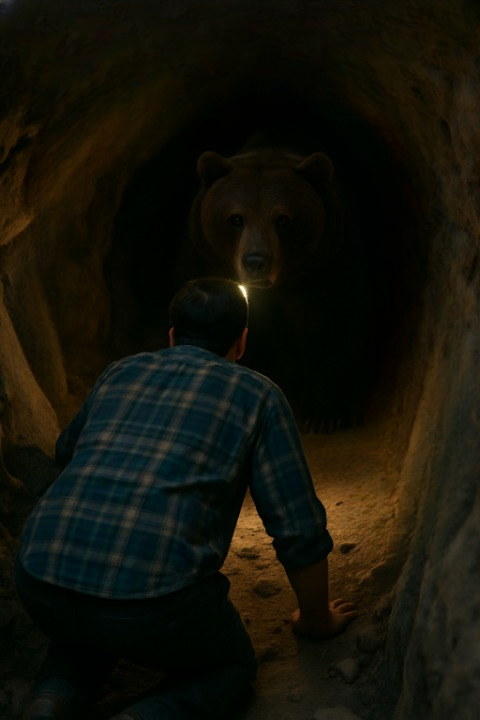Face-to-Face in the Shadows: An Unexpected Encounter in a Mountain Cave
The wilderness is a place where beauty and unpredictability exist side by side. It inspires us with its sights, sounds, and stillness — but it also reminds us that we are guests in a world where nature makes the rules. For one experienced hiker, a journey into a remote cave system became an unforgettable lesson in respect, caution, and coexistence.
Setting Out into the Mountains
It was the kind of morning that draws adventurers outdoors — crisp, fresh air carrying the scent of pine, and a bright sky that promised good weather. The hiker, a man in his late thirties, had spent years exploring rugged landscapes, from forested trails to rocky peaks. He was confident in his knowledge of these mountains, having visited the region many times before.
His goal that day was to explore a set of caves known to locals for their striking rock formations. Few visitors ventured there; the entrances were often hidden, and the paths inside could be narrow and winding. He packed light but carefully — a flashlight for navigating the darkness, water, basic safety gear, and his curiosity for the geological wonders hidden beneath the surface.
Entering the Depths
After several hours of hiking along uneven trails, he spotted an opening partially concealed between moss-covered boulders. Cool air drifted out, a natural invitation to step inside. Switching on his flashlight, he crouched and entered.
Inside, the cave walls shimmered with streaks of mineral color — deep reds, pale creams, and occasional flashes of silver. Water droplets clung to the ceiling, occasionally falling to the floor with a soft echo. The stillness was complete, as if the outside world had vanished.
An Unseen Presence
Moving deeper, he entered a larger chamber where the ceiling was decorated with stalactites shaped over thousands of years. As his light swept across the space, he noticed movement at the edge of his vision. At first, he thought it was a trick of the shadows — a common illusion in the uneven light of a cave.
Then he saw them: two eyes reflecting faintly in the darkness. Slowly, the outline of a large animal became clear. Only a few steps away stood a bear, its presence silent yet commanding.
A Moment of Stillness
Meeting a bear in the open is one thing; meeting one inside a cave is another. In such a confined space, there is no quick way to create distance. The bear lifted its head, sniffing the air to identify this unexpected visitor.
The hiker’s training and memory of wildlife safety advice kicked in. He avoided sudden movements, kept his posture relaxed, and took slow steps backward. His voice, low and steady, broke the silence — not because the bear could understand his words, but because speaking helped him stay calm.
A Peaceful Decision
The bear didn’t approach. Instead, after a pause, it turned and walked deeper into the cave, its heavy footsteps fading into the shadows. The encounter was over almost as suddenly as it had begun, leaving the hiker with both relief and awe.
Wildlife experts later explained that bears often prefer to avoid unnecessary conflict. The bear may have been resting, exploring the cave, or simply uninterested in confrontation. The hiker’s calm response and slow retreat likely signaled that he posed no threat.
Lessons from the Encounter
This peaceful resolution offers valuable reminders for anyone exploring wilderness areas:
- Be Prepared – Bring essential safety gear, especially in remote areas. Bear spray, a whistle, and a first-aid kit are as important as food and water.
- Learn Animal Behavior – Recognize signs of stress in wildlife. With bears, these can include huffing, paw stamping, or jaw snapping.
- Avoid Surprising Wildlife – In dense forest or enclosed spaces, make noise to alert animals of your presence before you get too close.
- Stay Calm if You Meet a Bear – Avoid running, keep your voice steady, and back away slowly while maintaining awareness of the animal’s movements.
- Respect Their Space – Remember that you are in their habitat. Giving wildlife room to move away helps prevent conflict.
Why These Stories Matter
Stories like this are more than personal memories — they are opportunities to learn. They show how human behavior can influence the outcome of a wildlife encounter. They also highlight the importance of conservation and the role animals play in maintaining the balance of natural ecosystems.
Bears, for example, help disperse seeds, control insect populations, and maintain healthy plant diversity. Respecting their space and protecting their habitats benefits not only the animals, but also the landscapes humans enjoy exploring.
A Lasting Impression
For the hiker, the encounter was humbling. “It wasn’t fear as much as it was respect,” he later reflected. “We both had the chance to harm each other, but instead, we both chose to walk away.”
In that moment, inside a mountain cave, two beings met and decided peace was the better option. It’s a reminder that in the wild, survival isn’t always about strength — sometimes it’s about understanding when not to act.




